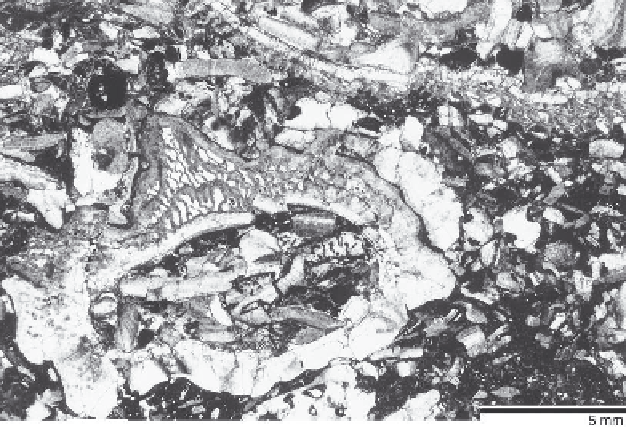Geology Reference
In-Depth Information
Fig. 16.8.
Rudist breccia.
Reef debris?
The thin section exhibits a fine-grained
limestone breccia consisting mostly of
poorly sorted rudist shells. Rudist brec-
cias have often been interpreted as
'forereef breccias', but many breccias
are more likely high-energy current de-
posits, storm layers, carbonate bodies
of prograding carbonate platforms, or
gravity-flow deposits. The sample is a
bioclastic packstone of a storm deposit
exhibiting larger rudist shells embed-
ded within skeletal debris consisting of
worn and rounded rudist fragments and
some echinoderms. Reworked rudist
reef material might be present, but this
must be checked by a paleontological
survey looking for characteristic reef
taxa. Late Cretaceous: Melenisce, S-
Slovenia.
stones cover a broad textural spectrum, including
boundstones, lime mudstones with or without spar-
filled cavities, wackestones and packstones as well as
grainstones. Reef talus and reef debris occur as litho-
clastic and biolithoclastic floatstones and rudstones, and
as carbonate breccia.
breccias' are a common feature of Cretaceous carbon-
ate platforms and ramps. These breccias represent just
one of three common limestone types with rudists that
can be recognized in outcrops and the subsurface
(Cestari and Sartorio 1995):
• Limestones with rudists in original growth position
(contributing to the formation of mounds);
• limestone with rudists not in original growth posi-
tion (contributing to tabular and mound-like geometries
of rudist limestones); and
• limestones composed of rudist fragments. This type
is the most common one. It is characterized by grain-
or mud-support and various levels of fragmentation,
abrasion and rounding of rudist shells.
The texture of the grain-supported microbreccia
shown in Fig. 16.8 indicates accumulation of strongly
reworked rudist shells. Whether the clasts were derived
from rudist reefs or not can be answered only by look-
ing for characteristic reef taxa within the clasts of the
breccia.
Massive reef limestone.
Fig. 16.7 shows a thin sec-
tion of a massive reef limestone characterized by abun-
dant corals and a fine-grained matrix. In the field the
occurrence of corals is restricted to areas of only few
square meters. Most of the limestone adjacent to the
coral sample is a microbial lime mudstone forming the
highest part of a carbonate mud mound.
Reef debris
. Many reefs have foreslopes consisting
of eroded reef-margin material (see Pl. 27/2). Reef
material can be transported far into the basin by tur-
bidity currents or debris flows. Storm-related transport
can lead to the accumulation of reef blocks and reef
debris both on the slope and in backreef and lagoonal
areas (see Sect. 12.1.2.2). The interpretation of the
source area is based on the occurrence of reef-diag-
nostic fossils and characteristic microfacies types.
However, a careful analysis of the composition of
the carbonates is necessary as shown by the sample
displayed in Fig. 16.8. The sample would be regarded
in the field as an indication of the existence of reefs
because of the abundance of rudist bivalve shells. Does
the thin section give a distinct clue to a deposition of
reef debris?
The life habitats of rudist bivalves ranged from pro-
tected restricted to open platforms, and to platform
margins, and also included deeper parts of ramps. Rud-
ists were able to build topographically relevant organic
mounds, but rarely gave origin to true reefs. 'Rudist
16.2.5.1 Basic Constituents of Reef and
Mound Carbonates
Rates of organic and skeletal growth, particulate sedi-
mentation and early cementation determine accretion
rates of reefs and mounds. In-place organic deposits
can be described compositionally in terms of the rela-
tive proportions of three major components - matrix
(M), skeletons (S) and cavity or cement (C). The MSC
triangular diagram proposed by Riding (2002) assists
in differentiating reef and mound types and separating
reef rock samples with respect to differences in origin
and environment. Fig. 16.9 and Fig. 16.10 can be used
for evaluating the major constituents of reef rocks.

